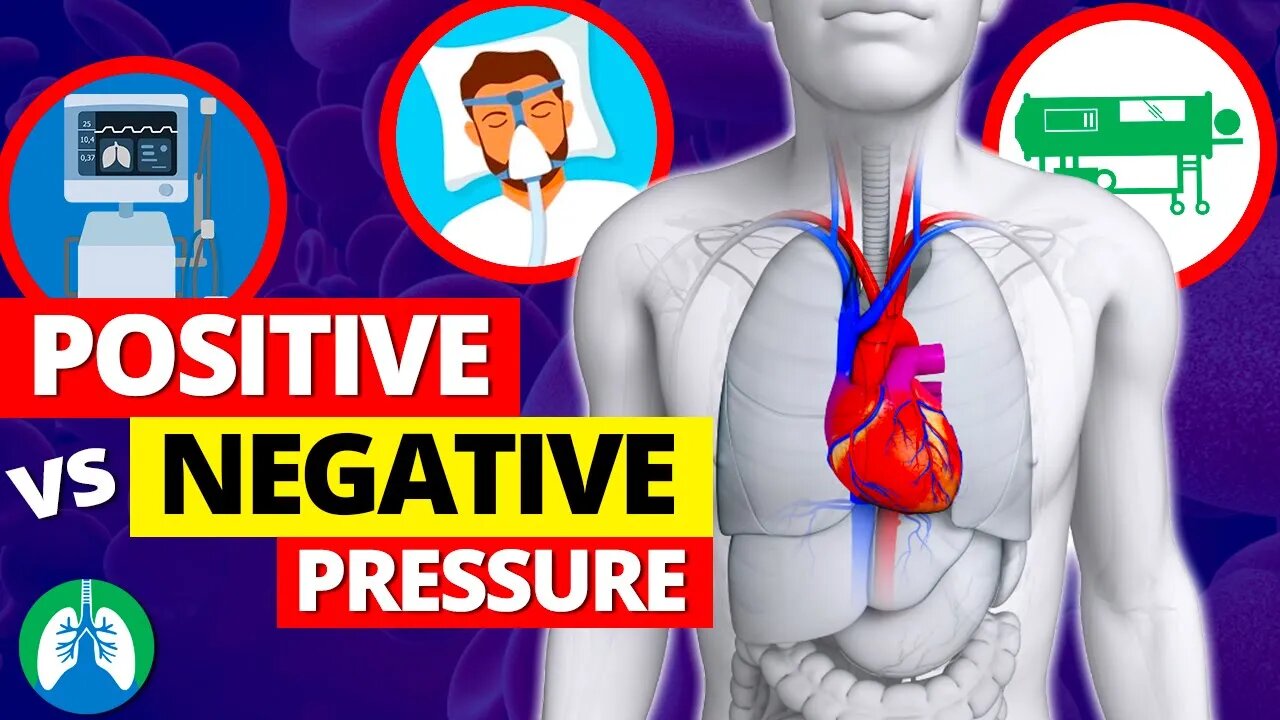Premium Only Content

Positive vs. Negative Pressure Ventilation *EXPLAINED*
What is the difference between positive and negative pressure ventilation? Watch this quick video to find out.
💥Positive vs. Negative Pressure Ventilation [Full Guide] ➜ ➜ ➜ https://bit.ly/3p4FS5q
➡️ Positive Pressure Ventilation
The most commonly used form in modern medical practice is positive pressure ventilation. As its name suggests, it uses positive pressure to push air into the lungs during the inspiratory phase of breathing.
➡️ Types
-- CPAP (Continuous Positive Airway Pressure): Used mainly for obstructive sleep apnea, maintains a continuous level of pressure.
-- BiPAP (BiLevel Positive Airway Pressure): Used for conditions like COPD and sleep apnea, provides different pressure levels for inhalation and exhalation.
-- Invasive Mechanical Ventilation: Used in severe cases, delivers air through an endotracheal tube.
-- High-Frequency Oscillatory Ventilation: Used mainly in neonates, delivers tiny volumes at high frequencies.
Advantages of positive pressure ventilation include flexible control over respiration parameters and applicability in both invasive and noninvasive forms. Disadvantages include the risk of barotrauma, ventilator-associated pneumonia, and negative effects on cardiac output due to increased intrathoracic pressure.
➡️ Negative Pressure Ventilation
This older, less common technique involves enclosing the patient’s body in an airtight chamber and reducing the pressure around the chest to create a vacuum that leads to inhalation.
➡️ Types
-- Iron Lung: Covers the whole body except the head, historically used during polio epidemics.
-- Chest Cuirass: Covers only the chest and abdomen, easier to use but requires a tight seal.
Some advantages of negative pressure ventilation include enabling spontaneous breathing and maintaining natural physiological responses, thereby promoting better circulation. Some disadvantages are its ineffectiveness in cases with stiff or non-compliant lungs and its impracticality for long-term management outside of the hospital.
While positive pressure ventilation is more commonly used due to its versatility and immediate relief in respiratory conditions, negative pressure ventilation remains valuable for specific cases such as neuromuscular diseases. Both have unique advantages and limitations that clinicians should carefully weigh based on individual patient needs, comfort, and underlying medical conditions. Therefore, a thorough understanding of both types is essential for optimizing patient care in various clinical scenarios.
💥Positive vs. Negative Pressure Ventilation [Full Guide] ➜ ➜ ➜ https://bit.ly/3p4FS5q
—————
📘 FREE STUFF
▪ Free Cheat Sheets 👉 https://bit.ly/3IKenWk
▪ TMC Practice Exam 👉 http://bit.ly/2XlwASL
📗 PASS THE TMC EXAM
▪ TMC Test Bank 👉 https://bit.ly/3QNqwLX
▪ TMC Exam Hacks 👉 https://bit.ly/3iLmVS2
▪ Daily TMC Practice Questions 👉 http://bit.ly/2NnXh3C
▪ TMC Bundle (Save $) 👉 https://bit.ly/3CWhdUn
📕 MORE FROM RTZ
▪ Test Bank (Free) 👉 http://bit.ly/2Kp73ln
▪ Glossary 👉 https://bit.ly/3g6s4Pj
▪ About Us 👉 http://bit.ly/2Xgk5YH
▪ Testimonials 👉 http://bit.ly/2x7b5Gl
🌐FOLLOW US
▪ Instagram 👉 http://bit.ly/2FhF0jV
▪ Twitter 👉 http://bit.ly/2ZsS6T1
▪ Facebook 👉 http://bit.ly/2MSEejt
▪ Pinterest 👉 http://bit.ly/2ZwVLPw
▪ Rumble 👉 https://bit.ly/3p7IS0H
▪ LinkedIn 👉 https://bit.ly/41uO2lx
🚑MEDICAL DISCLAIMER
This content is for educational and informational purposes only. It is not intended to be a substitute for professional medical advice, diagnosis, or treatment. Please consult with a physician with any questions that you may have regarding a medical condition. Never disregard professional medical advice or delay in seeking it because of something you watch in this video. We strive for 100% accuracy, but errors may occur, and medications, protocols, and treatment methods may change over time.
💡AFFILIATE DISCLAIMER
This description contains affiliate links. If you decide to purchase a product through one of them, we receive a small commission at no cost to you.
—————
⏰TIMESTAMPS
0:00 - Intro
0:33 - Positive Pressure Ventilation
0:51 - CPAP
0:59 - BiPAP
1:09 - Invasive Mechanical Ventilation
1:18 - High-Frequency Oscillatory Ventilation
1:29 - Advantages
1:39 - Disadvantages
1:51 - Negative Pressure Ventilation
2:10 - Iron Lung
2:21 - Chest Cuirass
2:29 - Advantages
—————
🖼CREDIT FOR MUSIC/GRAPHICS:
▪ Music licensed from Audiojungle.net/
▪ Graphics: Canva.com, Freevector.com, Vecteezy.com, and Pngtree.com
#mechanicalventilation #positivepressureventilation #negativepressureventilation
-
 4:01
4:01
Respiratory Therapy Zone
1 year agoLung Lobes and Fissures *EXPLAINED* 🫁
383 -
 1:46:14
1:46:14
Kim Iversen
5 hours agoTrump to Zelenskyy: 'You're Gambling with World War III'
47.9K91 -
 55:28
55:28
Glenn Greenwald
7 hours agoGlenn Reacts to Trump-Zelensky Exchange and Takes Q&A from our Members | SYSTEM UPDATE #415
88.3K182 -
 4:26:54
4:26:54
Nerdrotic
9 hours ago $27.79 earnedMarvel PANIC MODE! Kathleen Kennedy GONE?! Hollywood DEI Dead | Friday Night Tights 342 Nick Freitas
109K31 -
 1:30:03
1:30:03
Flyover Conservatives
23 hours agoZelensky Fail... God Called IT!; From Prison to the White House: Angela Stanton King’s Unbelievable Redemption Story | FOC Show
32.3K3 -
 1:06:14
1:06:14
IsaacButterfield
8 hours ago $1.25 earnedFree Speech Is Dead | Did Trump Go Too Far? | Sexist Job
32.6K17 -
 1:02:59
1:02:59
Sarah Westall
11 hours agoEpstein Files, Dueling Cabal Factions and Gold from Ancient Civilizations w/ Dave Hodges
62.8K18 -
 LIVE
LIVE
I_Came_With_Fire_Podcast
9 hours ago“Trump-Zelensky BEATDOWN | Europe BUILDS MUSCLE | NEWSCUM Podcast”
374 watching -
 41:25
41:25
CatfishedOnline
9 hours ago $1.11 earned23-Yr-Old Drove 2,650 Miles to Meet Online Girlfriend in Romance Scam
35.6K3 -
 1:56:18
1:56:18
Bare Knuckle Fighting Championship
2 days agoCountdown to BKFC FIGHT NIGHT ALBUQUERQUE & FREE LIVE FIGHTS!
34.3K2